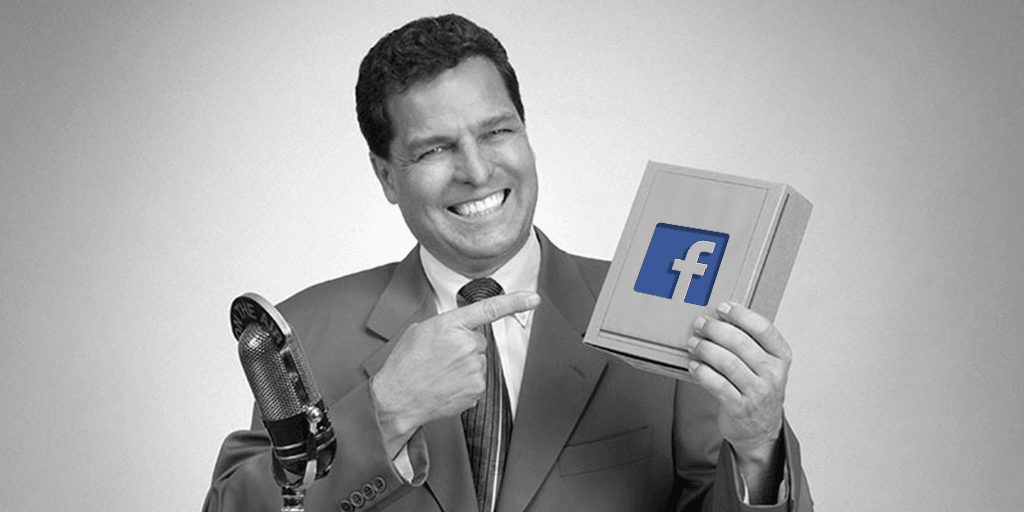Wondering how some companies get to spend $10K, $20K, or $50K a day, just on Facebook Ads, while you can’t even spend $100 per day and keep your CPA in the goal range?
Here’s the secret — it’s not just about CPC, CPM, CPA, or other C-metrics showing a correlation between the price and desired action.
I’m not saying those metrics don’t matter —they do — but if your ad isn’t communicating a message relevant to the potential customer, even a CPC of $0.01 won’t save you from the pain of failure (or a financial disaster).
Imagine a situation in which you have to explain what’s CPC to a group of 1000 people, consisting of both men and women, aged between 8 and 88, and make sure all of them understand. You have only shot to do it. Sounds hard?
It’s not hard — it’s impossible. It’s impossible to explain what’s CPC to 1000 different people by taking the same angle and communicating the same message…
But (there’s always a but), if you first segment the market, and then communicate the message based on the prospect’s interest and awareness of the problem, your chances for success will drastically increase. That is why you need to apply the 5 stages of market awareness in order to get the maximum results.

Marketing changes at a fast pace. However, fundamental rules stay the same because human nature doesn’t change…
The 3 Rights Rule
Most people consider advertising some kind of black voodoo magic that wraps a piece of shit in shiny paper which ultimately leads to hundreds of thousands or even millions of $ in sales in a period of one night. In the real world, things are a bit different than that…
Successful advertising starts with a good product that can provide added value to its customers. Only then, an advertiser can successfully apply the ‘The 3 Rights Rule’.
This rule helps us to increase the efficiency of the split testing process. Keep the message clear and simple at every stage of the marketing funnel.
1. Communicate the right message
2. Get in front of the right audience
3. At the right time
It has never been easier to get your message delivered to the right audience. But in the end, most of the digital advertising campaigns never achieve profitability or even see a break-even…
Keep that in mind when applying the 5 stages of market awareness.
What Social Media Actually Gave To Businesses & Advertisers?
Social media gave advertisers something that traditional ad placements could never give — two-way communication and direct (on spot) engagement.
When you look at the billboards, read the newspapers or watch the TV, direct engagement, occurs only if you have 2 or more people physically present at the same location. Once the conversation about the selected topic stops, it’s most likely that the 2nd engagement about the same topic will never occur, especially if the selected topic is an ad.
On the other hand, social media didn’t just give us a two-way communication between the advertiser and a potential buyer. It gave us a way to express our reactions, comment on the situation and share it with our friends and family, all of that, in just a few clicks.
In the past, advertisers couldn’t directly control who’s seeing the ads, what did a specific person see or when did they saw it… Yes, they could say that they’re going to push the ad in newspapers on Tuesday or that the radio ad should be cast at 5PM while people drive home from work, but still…

In 2022, we can control and see who saw it, how much time, how did he or she engage with it. But more importantly, we can serve the next ad based on the interaction with the previous ad.
This gave us end-to-end control over the whole marketing funnel.
Watched the first video to 50%? Good, serve the next video which tells the other 50%. Then serve the next ad which tells the next thing, and so on.
Ok, if delivering the message to the right audience isn’t a problem, and the timing isn’t a problem, how to determine what’s the right message?
5 Stages of Market Awareness

Theory of 5 Stages of Market Awareness (or 5 Stages of Market Sophistication) was originally introduced in the first edition of Breakthrough Advertising (1966) by Eugene Schwartz, one of the world’s greatest direct-response copywriters, ever.
Schwartz outlined how to craft an ad based on the customer awareness of your product/service and overall market awareness of a problem or the solution.

Although Schwartz initially explains his theory through the structure or a ‘job’ of the headline”, its implication goes far beyond that.
This is a place where most advertisers, companies, and marketing departments fail miserably.
They fail to understand and segment their market, and therefore, they fail to persuade people into buying their products.
The key to success is knowing when to offer what. You can’t show brand awareness messages to someone who visited your product page 5 times already. Also, you can’t aggressively push to sell to people that aren’t even aware they need your product.
It’s all about the stage of the user journey they are in.
Some users are at the point where they haven’t even realized they have a specific problem or need. On the other hand, others are in the phase of looking for the right product for them.
Your goal is to meet users in each stage of that journey and move them to the next one.
In order to do this, you need to:
- build a relationship with your target audience way before they become your users
- represent yourself as trustworthy and reliable
- position your product as a logical solution to the users’ problems

5 Stages of market awareness range from ‘Most aware’ to ‘Completely Unaware’, where ‘The Most aware’ audiences require direct-response approach and indirect approach works better on ‘Unaware’ audiences.
1. The Most Aware
Prospect knows of your brand and product, know what it does and knows he wants it.
At this point, these prospects know everything. What the product does, how it works, they like it and understand your brand and its values. They are ready to make a purchase.
Just one thing is standing between him and the purchase — the price.
In this type of situation, you should make them an irresistible offer. In other words — your ad should communicate something exclusive. For example, free shipping, bundle offers discounts or bonuses. Anything that will get them over the line between purchasers and non-purchasers.
The biggest mistake you can do here is to ignore what the prospects want. These people want a better price, and a better price only. They don’t want to hear about the additional perks and advantages of your products. Therefore, make sure you respond with the right action.
2. Product aware
Prospect knows of your brand but isn’t completely aware of what your product does or isn’t convinced of how well it solves the problem.
In other words, these people have made their research and found different products and services that meet their needs. Your product is just one of them.
People have already narrowed down their choices, so you should really excel in this phase.
In this stage, you need to additionally educate people on your product. First of all, show them how your product solves their problems. Show them all the benefits they might need to see, build trust and prove you are better than your competition.
On Facebook, this mostly comes down to a great retargeting campaign.
This is the most competitive place in the whole market. Place where big established brands spend their advertising $ to prove that their product is superior to their competitor’s product, and of course, acquire more revenues.
Basically, it all comes up to overturning a customer. From Coke to Pepsi, from PC to Mac, from Nike to Adidas, and the other way around.
3. Solution Aware
Prospect isn’t aware of your brand, nor product, but he’s aware that there is a solution to his problem or a desire — your product.
In this stage, people are making research and becoming aware of all the offers on the market. They are starting to get answers to their questions. In this phase, they are gaining the confidence they need to make a smart buying decision.
Your goal is to meet them at the right place and identify with the problem or the need they have. For this, you have to get into the prospects’ heads.
Serious demand for the solution definitely exists at this point, but the supply chain hasn’t yet emerged. It’s time to introduce a new product, a process more commonly known as ‘The Product Launch’.
You don’t need an ad with a plot twist that has its own plot twist. You just need to clearly address the problem and display the solution. In the final stage briefly explain how and why it will solve the addressed problem.
Note: Most new products or services which come to the market are at the 3rd or 4th stage of market awareness.
4. Problem Aware
Prospect is aware of his problem or a desire but isn’t aware that the solution even exists.
This is a common starting stage of the user journey. In this stage, users have questions. A lot of them. For this reason, they will start thinking about their problem. They will wonder what is it exactly, how it appeared, if others have the same problems, etc.
From this stage on, you will gradually guide the prospect through the next stages. Of course, if you manage to catch their attention.
To grab them, you need to get dramatic.
At this stage, your ad should showcase the problem or desire in a way that prospects can connect with your story. Then, show them you know how they feel. Dramatize the solution until the prospect realizes just how badly he needs the solution. Finally, present your product as the ultimate solution to the problem.
This approach to copywriting is also known as the Problem-Agitate-Solve approach used by Dan Kennedy.
5. Completely Unaware
Prospect isn’t aware of anything.
Schwartz says this is the most difficult one, and I’ll have to agree with him. Prospect at this stage of awareness doesn’t even realize that a problem or a desire exists. This often results in a very thin ROI, if it even exists.
Basically, this job is as hard as explaining what a computer is to a chimpanzee.

Just kidding. It’s not that hard, and it’s possible. Your ad should intrigue the audience with a shocking or unbelievable fact about the related topic.
Once they start reading (or watching) slowly transition from a real problem behind the unbelievable fact to a solution. Finally, present your product as an ultimate solution.
Here’s a great example, even though it’s not an ad;
Your customers make purchasing decisions based on the information they have. Then, they can’t buy something based on information they don’t have, right?
How to Implement 5 Stages of Market Awareness
Don’t mistake the 5 stages of market awareness for brand awareness. Even though they overlap and have a mutual connection, they’re not the same thing.
Don’t even try to build demand. It’s not your job. Your job, as a business owner, executive, or advertiser, is to recognize the market opportunity and seize your share of the market.

This powerful methodology can be used at every stage of your funnel, whether it’s cold traffic or re-targeting the prospects who visited your website.
Let’s assume you’re selling a course that helps people to lose weight and regain their health, and you want to sell in the United States.
You’ve conducted market research and found out that your target audience consists of women, aged 25 to 60. By investigating further, you’ve found that 60% of women in the U.S. are obese or overweight. There’s no need to seek further — you’re dealing with a mass-market opportunity.
By looking at the audience insights on Facebook, you can easily spot there are 70–80 million women aged 25 to 60 who are active on a monthly basis on Facebook. By crossing that number with the fact 60% of women in the U.S. have problems with weight — we get the exact potential of buyers in our market, which is 42–48 million women.
When you cross that audience with an interest in dieting, weight loss, healthy diet, and other big interest related to weight loss, that number drops — to 20–25 million.
So ok, our potential market on Facebook is 42–48 million women, but Facebook says there are only 20–25 million women that showed interest for weight loss, which accounts for around 47% of your potential market.

3 Different Groups of Awareness:
- The Most Aware,
- Product Aware
- Solution Aware.
They’re definitely aware of the problem and in most cases – they’re aware of the solution.
We’re left with around 53% of the market consisted of women who haven’t shown a direct in weight loss.
Those women mostly go into the:
- Solution Aware
- Problem Aware
- Completely Unaware
Now, since we’ve partially segmented the market, it’s time to start working on how to communicate your message. Decide which audience you’re going to tackle first.
Tackle only one at a time, start with the split testing of creatives, copies, and videos. In parallel with that, start the split testing process on your website. Even an amazing ad with a CPC of $0.01 won’t get you a sale if the landing page or the offer sucks.
Once you get that done, start tweaking the funnel. Aim for the highest possible conversion rate, scale, and work on increasing the average cart value. Then, repeat the whole process with the second audience, and so on.

Note: Have in mind that these are rough approximates made to showcase the market segmentation process.
What about Statistics?
Statistics aren’t hard to read — they’re hard to understand. I’ve once read that 92% of businesses advertising online never see a return on their investment.
That doesn’t mean you should hope you’re the 93rd person reading this blog in order to be successful.
That means — if you want to stay ahead of your competition, implement 5 stages of market awareness into your marketing system. Now.
Have anything to add? Comment below👇
Want to read more? Here’s the LINK!







Comments